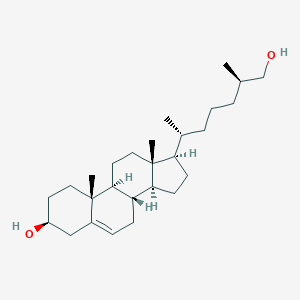Details of Metabolite
| Full List of Protein(s) Regulated by This Metabolite | ||||||
|---|---|---|---|---|---|---|
| ATP-binding cassette transporter (ABCT) | ||||||
| ATP-binding cassette A1 (ABCA1) | Click to Show/Hide the Full List of Regulating Pair(s): 1 Pair(s) | |||||
| Detailed Information |
Protein Info
 click to show the details of this protein click to show the details of this protein
|
|||||
| Regulating Pair |
Experim Info
 click to show the details of experiment for validating this pair click to show the details of experiment for validating this pair
|
[1] | ||||
| Introduced Variation | 27-Hydroxycholesterol addition (24 hours) | |||||
| Induced Change | ABCA1 mRNA levels: increase (FC = 1.8) | |||||
| Summary | Introduced Variation
|
|||||
| Disease Status | Lipid metabolism disorders [ICD-11: 5C52] | |||||
| Details | It is reported that 27-hydroxycholesterol addition causes the increase of ABCA1 mRNA levels compared with control group. | |||||
| ATP-binding cassette G1 (ABCG1) | Click to Show/Hide the Full List of Regulating Pair(s): 1 Pair(s) | |||||
| Detailed Information |
Protein Info
 click to show the details of this protein click to show the details of this protein
|
|||||
| Regulating Pair |
Experim Info
 click to show the details of experiment for validating this pair click to show the details of experiment for validating this pair
|
[1] | ||||
| Introduced Variation | 27-Hydroxycholesterol addition (24 hours) | |||||
| Induced Change | ABCG1 mRNA levels: increase (FC = 1.3) | |||||
| Summary | Introduced Variation
|
|||||
| Disease Status | Lipid metabolism disorders [ICD-11: 5C52] | |||||
| Details | It is reported that 27-hydroxycholesterol addition causes the increase of ABCG1 mRNA levels compared with control group. | |||||
| Transcription factor (TF) | ||||||
| Sterol regulatory element binding protein-1 (SREBF1) | Click to Show/Hide the Full List of Regulating Pair(s): 1 Pair(s) | |||||
| Detailed Information |
Protein Info
 click to show the details of this protein click to show the details of this protein
|
|||||
| Regulating Pair |
Experim Info
 click to show the details of experiment for validating this pair click to show the details of experiment for validating this pair
|
[1] | ||||
| Introduced Variation | 27-Hydroxycholesterol addition (24 hours) | |||||
| Induced Change | SREBF1 mRNA levels: increase (FC = 1.6) | |||||
| Summary | Introduced Variation
|
|||||
| Disease Status | Lipid metabolism disorders [ICD-11: 5C52] | |||||
| Details | It is reported that 27-hydroxycholesterol addition causes the increase of SREBF1 mRNA levels compared with control group. | |||||
| References | |||||
|---|---|---|---|---|---|
| 1 | 27-hydroxycholesterol is an endogenous ligand for liver X receptor in cholesterol-loaded cells. J Biol Chem. 2001 Oct 19;276(42):38378-87. | ||||
If you find any error in data or bug in web service, please kindly report it to Dr. Zhang and Dr. Mou.

